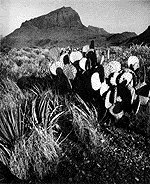In the past two million years, North America has experienced the coming and going of ice ages. During the ice ages, the Chihuahuan Desert existed only in our modern-day Mexico, in the southernmost part of its current range. Then, about 11,000 years ago, the last ice age ended. Ice was piled a mile high over the Great Lakes. The two major glaciers that covered North America—one stretching from the Hudson Bay down to Kansas and the other covering the Rockies down to Colorado—began to retreat.

And along with the ice went the precipitation. The weather patterns had changed and Big Bend was receiving less rain. The Chihuahuan Desert crept north into Texas and New Mexico.

In many ways, the Big Bend we see today is a product of the last 10,000 years. Before 10,000 years ago—a blink of a geologist’s eye—Big Bend wasn’t even a desert. Instead, it was a moist, hilly grassland. At elevations from 3,500 to 5,000 feet, there would have been mixed grass and woodlands, pinion and oak. Above 5,000 feet, there were extensive stands of aspen and coniferous trees.
Big Bend is not a desert because of its heat. It’s a desert because of its lack of water. The desert floor in Big Bend receives less than 12 inches of rain each year, while the mountains at five thousand feet receive about 18 inches annually.
Water and Rocks | Making a Desert | Fossils | Adaptations | People of the Desert | Ranching